Isoquinolones (isoquinolin-1(2H)-ones): the atom- and step-economic syntheses.
- alkyne
- annulation
- isoquinolone
1. Introduction
Annulation protocols with unsaturated hydrocarbons are the important and efficient methods for the syntheses of cyclic compounds with high atom-utilization and step-economy, which have been extensively investigated in the synthetic chemistry [1-10]. Isoquinolones are not only interesting and important nitrogen-heterocyclic compounds showing versatile biological and physiological activities, but also useful synthetic blocks [11-14]. Several efficient approaches are available for the syntheses of isoquinolones, and the reported early works include the reactions of pyrroline-2,3-diones with benzyne [15], reactions of dilithiated N-propenyl-ortho-toluamides [16], dilithiated 2-methyl-N-aryl -benzamides [17], multi-step including SNAr reaction [18].
Over the past decades, isoquinolone ring construction through inter-/intramolecular annulation protocols of unsaturated hydrocarbons with nitrogen-containing reaction partners have been a rapidly developed by the activation of aryl C-H, aryl C-X (X = halogen) bonds, as well as N-H or N-O bonds. Here an overview of the recent advances on the synthesis of isoquinolones is given.
2. Isoquinolone Formation via [4+2] Intermolecular Annulations and Analogous Reactions
The cyclocondensation of benzamide derivatives and fuctionalized arenes with alkynes or C2 synthons have been recently made great progress for the efficient access to isoquinolones via a [4+2] annulation manner. The computational studies on the transition-metal-catalyzed aryl C-H oxidative cyclocondensation of benzamides with alkynes affording isoquinolones have also been reported [19].
2.1 [4+2] Intermolecular Annulations via Aryl C-X/N-H Activation
The [4+2] intermolecular annulations of ortho-halobenzamides with alkynes via activation of aryl C-X (X = halogen)/N-H bond affording N-substituted isoquinolones have been extensively studied in the presence of nickel complexes under different conditions (Scheme 1).

With the use of air-stable [Ni(dppe)Br2] as catalyst, in the presence of Zn and Et3N, the reactions of ortho-halobenzamide with internal alkynes afford N-substituted isoquinolone derivatives (R' = alkyl, allyl, benzyl, aryl) in good to high yields [20]. In the cases of unsymmetric internal alkynes and terminal alkynes used, the cyclocondensation shows regioselective manner, and the catalytic procedure can be used for the synthesis of isoquinolinone alkaloid natural products.
Ni(dppp)Cl2 can also catalyze the annulation of ortho-iodobenzamides with alkynes in the presence of Et3N in MeCN by selective cleavage of C-I/N-H bond [21]. Very recently, Ni(cod)2/KOtBu-catalyzed formation of highly substituted isoquinolones through cyclocondensation of ortho-fluorobenzamides with internal alkynes via C-F/N-H activation has also been reported [22].
With the use of ortho-haloarylamidines as substrates, in the presence of H2O and zinc, Ni(dppp)Cl2-catalyzed annulations with terminal and internal alkynes affords N-aryl isoquinolones in good to high yields (Scheme 2) [23].

β-Keto esters are used as a C2 synthon in the formation of isoquinolones via [4+2] cyclocondensation with ortho-halobenzamides [24]. As shown in Scheme 3, CuI-catalyzed reactions of ortho-chloro, -bromo- and -iodobenzamides or ortho-chloronicotinamide with β-keto esters in the presence of Cs2CO3 without addition of any ligand or additive afford 3,4-disubstituted N-H isoquinolone derivatives in moderate to high yields.

In addition, as shown in Scheme 4, in the presence of Pd(OAc)2 and PtBu3HBF4, norbornadiene can also be used as an acetylene equivalent in the synthesis of 3,4-unsubstituted N-benzyl isoquinolones via the annulation with ortho-chlorobenzam- ides [25]. A Cu(OAc)2.H2O-catalyzed cyclocoupling reaction of N-substituted ortho-iodobenzamides with malononitrile can afford N-substituted-3-amino-4-cyano-isoquinolones in good to high yields, and malononitrile is used as C2 synthon [26].

The formation of functionalized isoquinolones by copper-catalyzed cyclocondensation of ketones with ortho-halobenzamides [27], or ortho-halobenzonitriles [28] through SNAr reaction giving α-aryl ketones as the intermediates have also been reported (Scheme 5).
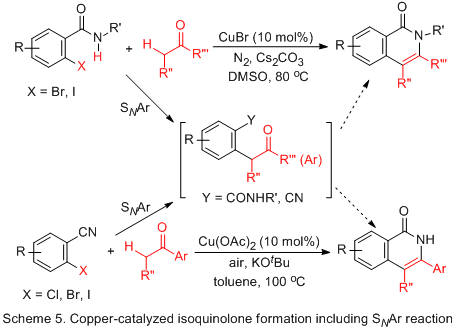
2.2 [4+2] Intermolecular Annulations via Aryl C-H/N-O Activation access to N-H Isoquinolones
Transition-metal-catalyzed annulations of alkynes with N-alkoxybenzamides by C-H/N-O bond cleavages with dealkoxylation reaction have been extensively investigated for the formation of N-H isoquinolones (Scheme 6).
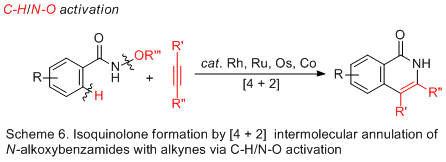
Guimond and coworkers firstly studied the cyclocondensation of N-alkoxybenzamides with internal alkynes catalyzed by [Cp*RhCl2]2/CsOAc in methanol to synthesize N-H isoquinolones via C-H/N-O bond activation in 2010 [29-30]. The group of CONH(OMe) is used as an oxidizing directing group, and the transformation occurs under external oxidant-free conditions.
The same catalyst system was then applied in the intramolecular reaction of alkyne-tethered N-alkoxybenzamides leading to a general and facile synthesis of 3-hydroxyalkyl-substituted N-H isoquinolones as the major products, and one of them can be used in the synthesis of natural product of rosettacin, which is a polycyclic fused isoquinolone derivative (vide infra) (Scheme 7) [31].
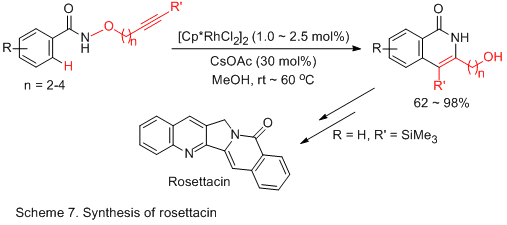
The similar reaction conditions were then applied by other groups in the [4+2] cyclocondensation of N-pivaloyloxy benzamides with vinyl acetate [32], cyclopropenes [33], and 1,1-di/tri-substituted allenes [34] to develop the synthesis of 3,4-unsubstituted N-H isoquinolones and 4-/3-substituted N-H isoquinolones, respectively (Scheme 8). In the case of vinyl acetate used, it emerges as the convenient acetylene equivalent.

In addition, 3,4-unsubstituted N-H isoquinolones can also be synthesized by annulation of benzoic acid with N-vinyl formamide catalyzed by [Cp*RhCl2]2 in the presence of AgOAc and KHCO3 in benzonitrile at 80 oC [35].
Thereafter catalysis of [Cp*RhCl2]2/Bu4NOAc in DCE [36], [RuCl2(p-cymene)]2/ NaOAc in MeOH [37-38], [RuCl2(p-cymene)]2/KO2CMes in water [39] and [RuCl2(p-cymene)]2/KO2CMes/Cu(OAc)2.H2O in CHCl3 [40], [Os(p-cymene)Cl2]2/ NaOAc/HOAc in trifluoroethanol (TFE) [41], Co(OAc)2.4H2O/AgOAc/PivOH in TFE [42] have been developed to synthesize N-H isoquinolones from the reactions of secondary N-alkoxybenzamides with internal alkynes via selective N-O bond cleavage. The use of free hydroxamic acids (R'" = H) is also successful to give the corresponding isoquinolones [39].
In addition, [RuCl2(p-cymene)]2/NaOAc in MeOH can be applied in the reactions of N-methoxybenzamide with alkynyl bromides affording 3-methoxy-4-substituted N-H isoquinolinones with excellent chemoselectivity via C−H/N−O activation [43]. Recently, the same catalyst system has been applied in the intramolecular cyclo-isomerization of alkyne-tethered N-alkoxybenzamides to give 3,4-disubstituted N-H isoquinolones (Scheme 9) [44]. The experimental and theoretical studies indicate that the reaction to the inverse annulation follows the Ru(II)-Ru(IV)-Ru(II) pathway involving N-O bond cleavage prior to alkyne insertion.

Moreover, the functionalized arenes have also been used as the coupling partners in the [4+2] annulations with alkynes to construct isoquinolone ring via activation of aryl C-H and N-E (E = N, C, O, Cl, etc) bonds. As shown in Scheme 10, with the use of [Cp*RhCl2]2 as catalyst, the annulations of alkynes with benzoyl hydrazines (Scheme 10-(a)) [45], with 1,4,2-dioxazol-5-ones occur at room temperature (Scheme 10-(b)) [46], with N-iminopyridinium ylides (Scheme 10-(c)) [47]. However, with the use of AgNTf2 as co-catalyst, the reactions of 2-aryloxazolines with alkynes afford N-substituted isoquinolones (Scheme 10-(d)) [48].

In the presence of KOAc, [Cp*Co(CO)I2]/AgOAc-catalyzed [4+2] annulation of N-chlorobenzamides with alkynes in TFE at room temperature with selective cleavage of C-H/N-Cl bonds (Scheme 11) [49]. In the case of terminal alkyne used, the reactions occurs with high regioselectivity to give 3-substituted N-H isoquinolones.

2.3 [4+2] Intermolecular Annulations via Aryl C-H/N-H Activation
More atom-economical procedures for the formation of isoquinolones is the oxidative [4+2] cyclocondensation of primary and secondary benzamides with internal alkynes with selective cleavages of C-H and N-H bonds (Scheme 12).
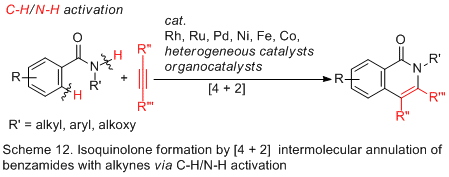
Miura and Satoh's group reported the oxidative coupling of primary, secondary, and tertiary benzamides with internal alkynes catalyzed by rhodium complex, and with the use of Cu(OAc)2.2H2O as oxidant in 2010 [50]. As shown in Scheme 13, the reaction between primary benzamides with internal alkynes affords isoquinolone fused polycyclic aromatics resulting from two molecules of alkynes incorporated. In the case of secondary benzamides, N-substituted isoquinolones form. Interestingly, the reaction of tertiary benzamides with internal alkynes under similar conditions produces 1-naphthalenecarboxamides through double aryl C-H bond activation (Scheme 14).

In the same year, two similar works were also reported using [Cp*RhCl2]2 as catalyst to synthesize N-substituted isoquinolones by oxidative/cyclization of benzamides with internal alkynes via selective aryl C-H/N-H bonds cleavage [51-52]. Other rhodium catalysis of [Cp*Rh(MeCN)3]BF4/K2CO3 in water under air was then developed [53].
Although [RuCl2(p-cymene)]2-catalyzed annulations of N-alkoxybenzamides (R' = alkoxy) with internal alkynes occur with dealkoxylation reactions via activation of N-O bond to give N-H isoquinolones [37-40], with the use of Cu(OAc)2·H2O as the terminal oxidant, and t-AmOH as the solvent, the oxidative annulation of N-alkyl/arylbenzamides (R' = alkyl, aryl) with internal alkynes gives efficient access to N-alkyl/aryl-substituted isoquinolones by highly selective cleavage of N-H bond [54-55].
In addition, when Pd(OAc)2 was used as a catalyst, in the presence of NaI.2H2O as additive, the methoxy substituent on nitrogen (R' = alkoxy) was not cleaved during the catalysis under air, the formation of N-methoxy isoquinolones is high chemoselectivity (Scheme 15) [56-57]. Under the similar reaction conditions, using Cu(II) salts as the co-oxidants, a broad range of N-alkyl and N-aryl substituted isoquinolones can also be obtained starting from N-alkyl/aryl benzamides, and N-C bonds are not cleaved either [58]. The mechanistic studies propose that the use of stoichiometric amount of Cu(II) salts as the key oxidant, and air as the terminal oxidant are key for the regeneration of active Pd(II) species.

The similar catalyst system was then applied in the oxidative annulation of N-methoxybenzamides with arynes and cyclooctynes via C−H/N−H activation for the synthesis of fused isoquinolones [59]. Very recently, the annulation of benzamides with arynes using palladium with photoredox dual catalysis has also been developed for the synthesis of benzo-fused isoquinolones [60].
The formation of N-alkyl-, aryl or alkoxy-substituted isoquinolones by the oxidative [4+2] cyclocondensation of secondary benzamides with internal alkynes with selective cleavages of C-H and N-H bonds has been achieved by using other transition-metal catalyst systems, such as nickel [61-62], iron [63] complexes as catalysts, and heterogeneous catalyst of palladium-nanoparticles [64], Pd/C [65-66].
In the presence of NaOPiv·H2O, Co(OAc)2·4H2O/Ag2O-catalyzed decarboxylative C-H/N-H activation/annulation of N-PyO benzamides with alkynyl carboxylic acids under air in TFE also affords 3-substituted isoquinolones with high regioselectivity [67]. Similarly, 3-substituted isoquinolones can be obtained by using Co(OAc)2·4H2O as catalyst from the reactions of N-(quinolin-8-yl)benzamides with alkynylsilanes with desilylation under oxygen in the same solvent, with the use of Mn(acac)2 and CsF [68].
In addition, the first metal-free annulation of N-methoxybenzamides with internal alkynes was reported by Antonchick’s group with the use of PhI as catalyst and AcOOH as oxidant in 1,1,1,3,3,3-hexafluoro-2-propanol (HFIP) at room temperature [69]. A mechanism involving the formation of hypervalent iodine reagent of (diacetoxyiodo)benzene (PIDA) is proposed. At the same time, this type of oxidative cycloaddition reaction can also occur by using bis(trifluoracetoxy)iodobenzene as oxidant in the presence of trifluoroacetic acid [70].
Rh(III)-catalyzed annulation of benzoyl hydrazines and alkynes affording isoquinolones with deammoniation by cleavage of N-N bond (Scheme 10-a). However, [Ru(p-cymene)Cl2]2/AgSbF6-catalyzed reactions of N-(1H-pyrrolo[2,3-b]pyridin-1-yl)benz-amides with internal alkynes afford isoquinolone derivatives with remaining N-N bond untouched (Scheme 16) [71]. In this procedure, N-amino-7-azaindole is used as an efficient bidentate-directing group to promote the selective C-H bond activation.
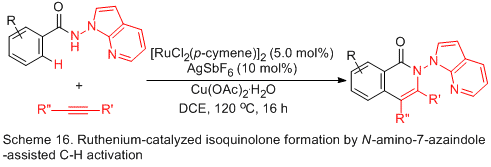
On the other hand, instead of internal alkynes, the annulations of benzamides with other C2 synthons via C-H/N-H activation to construct isoquinolone ring have also been developed. For example, Glorius and coworkers developed a Rh(III)-catalyzed intermolecular [4+2] cyclocondensation of N-methoxybenzamides with α-halo and pseudohalo ketones to afford various 3-substituted N-methoxyisoquinolones in moderate to excellent yields (Scheme 17) [72]. The α-halo and pseudohalo ketones are utilized as oxidized alkyne equivalents to undergo the redox-neutral annulation, and through the formation of ortho-acylmethyl-benzamides as the intermediates. Recently, Ma and coworkers have also reported a Pd(OAc)2/L-alanine-catalyzed formation of 3-substituted N-(quinolin-8-yl)-isoquinolones with by N-(quinolin-8-yl)benzamides and α-bromo ketones in the presence of K2CO3 in t-AmOH [73].

With the use of same rhodium complex, 4-substituted isoquinolones can be obtained by a microwave-assisted annulation of N-methoxyamides with α-chloroaldehydes (Scheme 18) [74].

3-Cyclohexylmethyl N-methoxyisoquinolone, which was published as only one example in literature [75], can be synthesized by the cyclocondensation of N-methoxyisoquinolone with the corresponding a-carbonyl sulfoxonium ylide catalyzed by rhodium in HFIP (Scheme 19). The detailed studies for the formation of 3-substituted isoquinolones through the reactions of N-methoxybenzamides and α-carbonyl sulfoxonium ylides catalyzed by Cp*Rh(MeCN)3(SbF6)2/Zn(OTf)2 in DCE were then reported by Li and coworkers [76].

Very recently, epoxides as alkylating reagents and C2 synthon have been applied in Pd(OAc)2-catalyzed oxidative annulation of N-alkoxybenzamides to regioselectively synthesize 3-substituted isoquinolones in HFIP solvent (Scheme 20) [77]. The present methodology has been successfully employed in the total syntheses of rupreschstyril, siamine, and cassiarin A.

In addition, as depicted in Scheme 3, β-keto esters can be used as a C2 synthon in the formation of isoquinolones via cyclocondensation with ortho-halobenzamides catalyzed by CuI. However, in the presence of Pd(OOCCF3)2 and K2S2O8, the reactions of N-alkoxybenzamides with β-keto esters have also been developed for the synthesis of isoquinolones via selective C-H/N-H activation [78].
Moreover, as shown in Scheme 21, in the presence of [Cp*RhCl2]2, the regioselective formation of substituted isoquinolones through cyclocondensation of N-methoxybenzamide [79] or primary benzamides [80] with diazo compounds has also been developed. In the case of N-methoxybenzamide used, C-H/N-H activation occurs selectively.
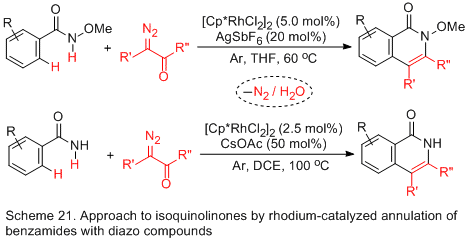
Similarly, [Cp*RhCl2]2/KOAc-catalyzed intermolecular cyclization between N-methoxybenzamide and 4-diazoisochroman-3-imines provides 3-amino-4-aryliso- quinolones via a selective N-O cleavage of 4-diazoisochroman-3-imines (Scheme 22) [81].

The construction of isoquinolone ring can also be realized by the annulation of carbon-carbon double bonds with benzamides with selective C-H/N-H activation.
For example, with the use of Mn(OAc)3·2H2O as the oxidant and NaOPiv·H2O as the base in TFE, Thrimurtulu and coworkers developed a Co(acac)2-catalyzed isoquinolone synthesis by the intermolecular cyclization between N-(quinolin-8-yl)benzamides and substituted allenes at room temperature to give 3-substituted N-(quinolin-8-yl)isoquinolones [82]. In addition, in the presence of Ag2CO3 and Cs2CO3, Co(OAc)2 can catalyze the similar cyclization in the same solvent giving isoquinolones [83].
The catalysts system of [Cp*Rh(MeCN)3][SbF6]2/Cu(OAc)2 in HFIP also shows highly catalytic activity in the cyclocondensation of N-methoxybenzamides with nitroalkenes for the selective synthesis of 4-substituted N-methoxyisoquinolones [84].
3. Isoquinolone Syntheses via [5+1] Intermolecular Annulation between ortho- (1-Alkynyl)benzaldehyde and Primary Amines
Readily available ortho-(1-alkynyl)benzaldehydes have been well-applied in the synthesis of benzo-fused heterocycles [85-91] and carbocycles [92-97], which are also used as C5 synthon in the syntheses of isoquinolones by the intermolecular [5+1] cyclocondensation with primary amines.
As shown in Scheme 23, in the presence of SiO2, using an excess amount of CuBr·SMe2, the aerobic cyclocondensation of ortho-(1-alkynyl)benzaldehydes with benzyl amines or primary aliphatic amines affords 4-bromoisoquinolones [98]. Cu(OAc)2-catalyzed cyclocondensation of ortho-(1-alkynyl)benzaldehydes with aniline gives 2,3-diphenylisoquinolone in 63% yield [99], Zn(OTf)2 also shows catalytic activity for the aerobic cyclocondensation of ortho-(1-alkynyl)benzaldehydes with arylamines to give N-arylated isoquinolones [100].

4. Isoquinolone Syntheses via Other Intermolecular Annulations
A Ni(cod)2/phosphine-catalyzed denitrogenative alkyne insertion reaction of 1,2,3-benzotriazin-4(3H)-ones provides an alternatively efficient approach to substituted isoquinolones (Scheme 24) [101]. A wide range isoquinolones can be obtained in high yields with the use of internal/terminal alkynes, including borylalkynes. This transformation can also be realized under visible-light irradiation with the assistance of a photocatalyst at room temperature [102].

In addition, the similar catalyst system can also catalyze a decarbonylative addition of phthalimides to internal alkynes to afford highly substituted isoquinolones (Scheme 25) [103]. The similar transformation can take place by using CoI2/phosphine/Ag2CO3 [104], and Rh(PPh3)2(CO)Cl as the catalyst systems [105].

The isoquinolone skeleton can also be constructed by a Pd(OAc)2-catalyzed carbonylation/decarboxylation of diethyl(2-iodoaryl)malonates with imidoyl chlorides and CO in THF (Scheme 26) [106].

The annulation reaction between benzocyclobutenols and isocyanates catalyzed by [RhOH(cod)]2 can also produce isoquinolone derivatives with excellent regioselectivity and functional-group tolerance (Scheme 27) [107]. The reactions give the first examples of formal amide fragment insertion into a aryl C−C(sp3) bond.

5. Isoquinolone Syntheses via Intramolecular Annulation Reactions
Isoquinolone syntheses via intramolecular annulation can be achieved starting from a variety of substrates. For example, the intramolecular cyclization of phosphorylated aromatic carboxamides promoted by base [108], palladium-catalyzed intramolecular cyclization of ortho-ethynylbenzamides [109], ortho-iodo-N-allenylbenzamides [110], palladium-catalyzed or base-promoted intramolecular cyclization of ortho-allenyl-N- substituted benzamides generated in situ [111].
When ortho-(2-substituted ethynyl)benzonitriles and NaOMe were refluxed in methanol for 16 h, both isoindolones and isoquinolones formed in different ratios, depending on the nature of substituents. Substrates bearing the phenyl and thienyl group, stabilizing the α-anion favor the 5-exo-pathway to give isoindolones. Whereas pyridinyl and pyrazinyl groups can also stabilize the α-anion, but the formation of a more stable intermediate by coordination of sodium with nitrogen atom leads to the formation of isoquinolones via 6-endo cyclization (Scheme 28) [112].
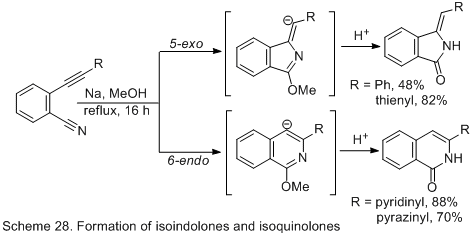
In addition, in the presence of platinum complexes, the intramolecular cyclization of ortho-alkynylbenzonitriles in alcohols produces 3-substituted isoquinolones [113].
Treatment of ortho-iodobenzoyl azides with terminal alkynes in the presence of Pd/C, PPh3, and CuI in EtOH at 80 oC under N2 afforded 3-substituted isoquinolones as the major products [114]. The formation of isoquinolones is proposed involving in situ generation of ortho-alkynyl benzoyl azides via Pd/C-mediated Sonogashira coupling followed by intramolecular acetylenic Schmidt reaction with denitrogenation (Scheme 29). Aliphatic terminal alkynes show high chemoselectivty to give the corresponding isoquinolones in good to high yields, whereas the use of aryl alkynes affords the desired products in low yield along with other side products.

In the presence of H2O, Cu(OAc)2.H2O-catalyzed a tandem cyclization reaction of 2-(1-alkynyl)arylaldimines produces highly substituted isoquinolone derivatives (Scheme 30) [115].

4-Substituted isoquinolones can be prepared by a DBU-promoted isomerization of 4-(diarylmethylidene)-3,4-dihydroisoquinolinones, which are generated via the palladium-catalyzed tandem Heck-Suzuki coupling reactions of ortho-iodo-N-(prop-2-ynyl)benzamides with arylboronic acids under mild conditions (Scheme 31) [116].

As shown in Scheme 8, the [4+2] cyclocondensation of N-alkoxybenzamides with vinyl acetate gives 3,4-unsubstituted N-H isoquinolones, and vinyl acetate is a good acetylene equivalent. The other approach to 3,4-unsubstituted N-H isoquinolones is designed from the acid-promoted intramolecular cyclization of ortho-vinyl ether benzamides, which are pre-prepared by Suzuki cross-coupling reactions of boronic ester with ortho-bormobenzamides (Scheme 32-a) [117]. In trifluoroacetic acid (TFA) as solvent, the intramolecular cyclization occurs to form isoquinolone ring with t-butyl group removed under the strong acidic conditions and microwave irradiation. A similar procedure was reported under mild conditions promoted by HCl in dioxane to give N-substituted 3,4-unsubstituted isoquinolones (Scheme 32-(b)) [118].
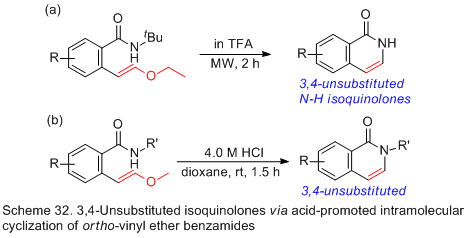
6. Polycyclic Fused Isoquinolone Formation via Alkyne Annulation
Annulation protocols under different conditions have been extensively studied for one-pot and efficient approach to polycyclic fused isoquinolones [119-122]. Transition metal-catalyzed procedures focus on the use of [Cp*RhCl2]2, [RuCl2(p-cymene)]2, and CuCl catalysts, through the intermolecular annulation of alkynes with benzamides and intramolecular annulation of alkyne-tethered benzamides, which are reviewed in this section.
In 2010, Li and coworker reported a [Cp*RhCl2]2-catalyzed double oxidative cyclocoupling of primary benzamides with two molecules of alkynes affording tetracyclic isoquinolones resulting from the formation of two C-N bonds and two C-C bonds simultaneously (Scheme 33) [52]. In the presence of CsOAc, the same catalyst also catalyzes the cyclization of N-(pivaloyloxy)benzamide with cyclohexadienone-containing 1,6- enynes, providing one-pot synthesis of tetracyclic isoquinolones under mild conditions (Scheme 34) [123].


In the presence of additive and/or oxidant, [Cp*RhCl2]2-catalyzed formation of other polycyclic fused isoquinolones is shown in Scheme 35. 2,3-Dihydropyrrolo[1,2-b]iso- quinolin-5(1H)-ones (n = 1) [124], and isoindolo[2,1-b]isoquinolin-5(7H)-ones (n = 1) [125] can be prepared by intramolecular annulations of alkyne tethered benzamides, and the latter approach is used in the synthesis of nitrogen-containing natural products such as rosettacin and oxypalmatime. The intermolecular cascade annulation between N-pivaloyloxy benzamides and ortho-alkynylbenzaldehydes can give 7-hydroxyisoindolo[2,1-b]-isoquinolin-5(7H)-ones, and also afford the convenient intermediates for access to rosettacin [126, 127]. In addition, the intermolecular cyclization of N-pivaloyloxy benzamides with conjugated enynones affords pyrrolo[1,2-b]isoquinolin-5(3H)-ones [128]. All the formed polycyclic isoquinolones are not easily available to be synthesized by multi-step traditional organic transformation.

As described in Scheme 7, [Cp*RhCl2]2/CsOAc-catalyzed the intramolecular reaction of alkyne-tethered N-alkoxybenzamides leads to 3-hydroxyalkyl-substituted N-H isoquinolones by selective C-H/N-O activation [31]. However, CuCl-catalyzed the aerobic oxidative radical cascade annulations of the similar substrates give isoxazolidine/1,2-oxazinane-fused isoquinolones, and N-O bond is untouched (Scheme 36) [129]. This transformation features air as the environment-friendly oxidant and has the merits of a cheap catalyst, broad substrates scope, high atom economy and simple operation.

Very recently, the formation of isoxazolidine-fused isoquinolones starting from alkyne-tethered N-alkoxybenzamides has been reported by electrochemical-oxidation-induced [130], and PhI(OAc)2-mediated [131] intramolecular annulations.
[Ru(p-cymene)Cl2]2 not only shows the catalytic activity for the construction of isoquinolone ring as described-above, but also has been employed as catalyst in the formation of polycyclic fused isoquinolones, such as tetracyclic isoquinolones [132], and spiro-fused-isoquinolones [133] (Scheme 37).

7. Conclusion
This mini-review summaries the representative reports on the syntheses of isoquinolones and polycyclic fused isoquinolones by annulation protocols in one-pot manner, which show atom- and step-economy. The new trend of developing annulation reactions in the synthesis of cyclic compounds has recently been diversified, in addition to transition-metal catalysis, the electrocatalysis [134-138], and photocatalysis [139-141] with or without combination of metal-catalyzed catalysis have also become the novel and elegant methods in annulation synthesis. The construction of isoquinolone ring under these conditions has also been developed via [4+2] annulation of benzamides with terminal/internal alkynes [142-148].
References
- Nakamura, I.; Yamamoto, Y. Transition-metal-catalyzed reactions in heterocyclic synthesis. Chem. Rev. 2004, 104, 2127.
- Zeni, G.; Larock, R. C. Synthesis of heterocycles via palladium π-olefin and π-alkyne Chemistry. Chem. Rev. 2004, 104, 2285.
- Hua, R.; Abrenica, M.V.A.; Wang, P. Cycloaddition of alkynes: Atom-economic protocols for constructing six-membered cycles. Curr. Org. Chem. 2011, 15, 712.
- Gulevich, A.V.; Dudnik, A.S.; Chernyak, N.; Gevorgyan, V. Transition metal-mediated synthesis of monocyclic aromatic heterocycles. Chem. Rev. 2013, 113, 3084.
- Nizami, T.A.; Hua, R. Cycloaddition of 1,3-butadiynes: Efficient synthesis of carbo- and heterocycles. Molecules 2014, 19, 13788.
- Fang, G.; Bi, X. Silver-catalyzed reactions of alkynes: recent advances. Chem. Soc. Rev. 2015, 44, 8124.
- Huang, M.-H.; Hao, W.-J.; Li, G.; Tu, S.-J.; Jiang, B. Recent advances in radical transformations of internal alkynes. Chem. Commun. 2018, 54, 10791.
- Zheng, L.; Hua, R. C–H activation and alkyne annulation via automatic or intrinsic directing groups: Towards high step economy. Chem. Rec. 2018, 18, 556.
- Hua, R.; Nizami, T.A. Synthesis of heterocycles by using propargyl compounds as versatile synthons. Mini-Rev. Org. Chem. 2018, 15, 198.
- Zheng, L.; Hua, R. Recent advances in construction of polycyclic natural product scaffolds via one-pot reactions involving alkyne annulation. Front. Chem. 2020, 8, 580355.
- Strumberg, D.; Pommier, Y.; Paull, K.; Jayaraman, M.; Nagafuji, P.; Cushman, M. Synthesis of cytotoxic indenoisoquinoline topoisomerase I poisons. J. Med. Chem. 1999, 42, 446.
- Glushkov, V. A.; Shklyaev, Y. V. Synthesis of 1(2H)-isoquinolones. Chem. Heterocycl. Compd. 2001, 37, 663 and references cited therein.
- Cappelli, A.; Mohr, G. P.; Giuliani, G.; Galeazzi, S.; Anzini, M.; Mennuni, L.; Ferrari, F.; Makovec, F.; Kleinrath, E. M.; Langer, T.; Valoti, M.; Giorgi, G.; Vomero, S. Further studies on imidazo[4,5-b]pyridine AT1 angiotensin II receptor antagonists. Effect of the transformation of the 4-phenylquinoline backbone into 4-phenylisoquinolinone or 1-phenylindene scaffold. J. Med. Chem. 2006, 49, 6451.
- Li, B.; Feng, H.; Wang, N.; Ma, J.; Song, H.; Xu, S.; Wang, B. Ruthenium-catalyzed oxidative coupling/cyclization of isoquinolones with alkynes through C-H/N-H activation: mechanism study and synthesis of dibenzo[a,g]quinolizin-8-one derivatives. Chem. Eur. J. 2012, 18, 12873.
- Cobas, A.; Guitián, E.; Castedo, L. Synthesis of 3-phenylisoquinolones by reaction of simple pyrroline-2,3-diones with benzyne. New mechanistic considerations. J. Org. Chem. 1993, 58, 3113.
- Fisher, L. E.; Muchowski, J. M.; Clark, R. D. Heteroatom-directed metalation. Lithiation of N-propenylbenzamides and N-propenyl-o-toluamides. Novel routes to ortho-substituted primary benzamide derivatives and N-unsubstituted isoquinolin- 1(2H)-ones. J. Org. Chem. 1992, 57, 2700.
- Davis, S. E.; Church, A. C.; Griffith, C. L. M.; Beam, C. F. The preparation of substituted 1(2H)-isoquinolinones from dilithiated 2-methyl-N-arylbenzamides, 2-methyl-N-(arylmethyl)benzamides, or 2-methylbenzoic acid, 2,2-dimethylhy-drazide. Synth. Commun. 1997, 27, 2961.
- Snow, R. J.; Butz, T.; Hammach, A.; Kapadia, S.; Morwick, T. M.; Prokopowicz, III, A. S.; Takahashi, H.; Tan, J. D.; Tschantz, M. A.; Wang, X.-J. Isoquinolinone synthesis by SNAr reaction: a versatile route to imidazo[4,5-h]isoquinolin-9-ones. Tetrahedron Lett. 2002, 43, 7553.
- Omer, H. M.; Liu, P. Computational study of the Ni-catalyzed C−H oxidative cycloaddition of aromatic amides with alkynes. ACS Omega 2019, 4, 5209.
- Liu, C.-C.; Parthasarathy, K.; Cheng, C.-H. Synthesis of highly substituted isoquinolone derivatives by nickel-catalyzed annulation of 2-halobenzamides with alkynes. Org. Lett. 2010, 12, 3518.
- Weng, W.-Z.; Xie, J.; Zhang, B. Mild and efficient synthesis of indoles and isoquinolones via a nickel-catalyzed Larock-type heteroannulation reaction. Org. Biomol. Chem. 2018, 16, 3983.
- Nohira, I.; Liu, S.; Bai, R.; Lan, Y.; Chatani, N. Nickel-catalyzed C-F/N-H annulation of aromatic amides with alkynes: Activation of C-F bonds under mild reaction conditions. J. Am. Chem. Soc. 2020, 142, 17306.
- Xie, H.; Xing, Q.; Shan, Z.; Xiao, F.; Deng, G.-J. Nickel-catalyzed annulation of o-haloarylamidines with aryl acetylenes: Synthesis of isoquinolone and 1-aminoisoquinoline Derivatives. Adv. Synth. Catal. 2019, 361, 1896.
- Wang, F.; Liu, H.; Fu, H.; Jiang, Y.; Zhao, Y. An efficient one-pot copper-catalyzed approach to isoquinolin-1(2H)-one derivatives. Org. Lett. 2009, 11, 2469.
- Thansandote, P.; Hulcoop, D. G.; Langer, M.; Lautens, M. Palladium-catalyzed annulation of haloanilines and halobenzamides using norbornadiene as an acetylene synthon: A route to functionalized indolines, isoquinolinones, and indoles. J. Org. Chem. 2009, 74, 1673.
- Liu, Y.; Zeng, R.; Pan, J.; Zou, J. Copper(II)-catalyzed synthesis of N-substituted-3-amino-4-cyano-isoquinoline-1(2H)-ones by the reaction of N-substituted-2-iodobenzamides with malononitrile. Chin. J. Chem. 2014, 32, 883.
- Shi, Y.; Zhu, X.; Mao, H.; Hu, H.; Zhu, C.; Cheng, Y. Synthesis of functionalized isoquinolin-1(2H)-ones by copper-catalyzed a-arylation of ketones with 2-halobenzamides. Chem. Eur. J. 2013, 19, 11553.
- Mayo, M. S.; Yu, X.; Feng, X.; Yamamoto, Y.; Bao, M. Isoquinolone synthesis through SNAr reaction of 2-halobenzonitriles with ketones followed by cyclization. J. Org. Chem. 2015, 80, 3998.
- Guimond, N.; Gouliaras, C.; Fagnou, K. Rhodium(III)-catalyzed isoquinolone synthesis: The N-O bond as a handle for C-N bond formation and catalyst turnover. J. Am. Chem. Soc. 2010, 132, 6908.
- Guimond, N.; Gorelsky, S. I.; Fagnou, K. Rhodium(III)-catalyzed heterocycle synthesis using an internal oxidant: Improved reactivity and mechanistic studies. J. Am. Chem. Soc. 2011, 133, 6449.
- Xu, X.; Liu, Y.; Park, C.-M. Rhodium(III)-catalyzed intramolecular annulation through C-H activation: Total synthesis of (±)-Antofine, (±)-Septicine, (±)-Tylophorine, and Rosettacin. Angew. Chem. Int. Ed. 2012, 51, 9372.
- Webb, N. J.; Marsden, S. P.; Raw, S. A. Rhodium(III)-catalyzed C-H activation/annulation with vinyl esters as an acetylene equivalent. Org. Lett. 2014, 16, 4718.
- Hyster, T. K.; Rovis, T. Rhodium(III)-catalyzed C–H activation mediated synthesis of isoquinolones from amides and cyclopropenes. Synlett 2013, 24, 1842.
- Wang, H.; Glorius, F. Mild rhodium(III)-catalyzed C-H activation and intermolecular annulation with allenes. Angew. Chem. Int. Ed. 2012, 51, 7318.
- Sun, R.; Yang, X.; Li, Q.; Xu, K.; Tang, J.; Zheng, X.; Yuan, M.; Fu, H.; Li, R.; Chen, H. Divergent synthesis of isoquinolone and isocoumarin derivatives by the annulation of benzoic acid with N-vinyl amide. Org. Lett. 2019, 21, 9425.
- Coles-Taylor, B. L.; McCallum, M. S.; Lee, J. S.; Michel, B. W. Accessing 4-oxy-substituted isoquinolinones via C–H activation and regioselective migratory insertion with electronically biased ynol ethers. Org. Biomol. Chem. 2018, 16, 8639.
- Li, B.; Feng, H.; Xu, S.; Wang, B. Ruthenium-catalyzed isoquinolone synthesis through C-H activation using an oxidizing directing group. Chem. Eur. J. 2011, 17, 12573.
- Guntreddi, T.; Shankar, M.; Kommu, N.; Sahoo, A. K. Construction of pyranoisoquinolines via Ru(II)-catalyzed unsymmetrical double annulation of N-methoxybenzamides with unactivated alkynes. J. Org. Chem. 2019, 84, 13033.
- Ackermann, L.; Fenner, S. Ruthenium-catalyzed C-H/N-O bond functionalization: Green isoquinolone syntheses in water. Org. Lett. 2011, 13, 6548.
- Krieger, J.-P.; Ricci, G.; Lesuisse, D.; Meyer, C.; Cossy, J. Harnessing C-H activation of benzhydroxamates as a macrocyclization strategy: Synthesis of structurally diverse macrocyclic isoquinolones. Chem. Eur. J. 2016, 22, 13469.
- Yang, J.; Wu, L.; Xu, H.; Gao, H.; Zhou, Z.; Yi, W. Redox-neutral [4+2] annulation of N-methoxybenzamides with alkynes enabled by an osmium(II)/HOAc catalytic system. Org. Lett. 2019, 21, 9904.
- Liu, M.; Niu, J.-L.; Yang, D.; Song, M.-P. Development of a traceless directing group: Cp*-free cobalt-catalyzed C-H activation/annulations to access isoquinolinones. J. Org. Chem. 2020, 85, 4067.
- Huang, H.; Nakanowatari, S.; Ackermann, L. Selectivity control in ruthenium(II)-catalyzed C-H/N-O activation with alkynyl bromides. Org. Lett. 2017, 19, 4620.
- Song, L.; Zhang, X.; Tang, X.; Van Meervelt, L.; Van der Eycken, J.; Harvey, J. N.; Van der Eycken, E. V. Ruthenium-catalyzed cascade C–H activation/annulation of N-alkoxybenzamides: reaction development and mechanistic insight. Chem. Sci. 2020, 11, 11562.
- Yu, B.; Chen, Y.; Hong, M.; Duan, P.; Gan, S.; Chao, H.; Zhao, Z.; Zhao, J. Rhodium-catalyzed C–H activation of hydrazines leads to isoquinolones with tunable aggregation-induced emission properties. Chem. Commun. 2015, 51, 14365.
- Zhu, H.; Zhuang, R.; Zheng, W.; Fu, L.; Zhao, Y.; Tu, L.; Chai, Y.; Zeng, L.; Zhang, C.; Zhang, J. Synthesis of isoquinolone via rhodium(III)-catalyzed C-H activation with 1,4,2-dioxazol-5-ones as oxidizing directing group. Tetrahedron 2019, 75, 3108.
- Li, X.; Zhang, R.; Qi, Y.; Zhao, Q.; Yao, T. Rhodium(III)-catalyzed C-H activation/annulation of N-iminopyridinium ylides with alkynes and diazo compounds. Org. Chem. Front. 2021, 8, 1190.
- Yang, Z.; Jie, L.; Yao, Z.; Yang, Z.; Cui, X. Rhodium (III)-catalyzed synthesis of N-(2-acetoxyalkyl)isoquinolones from oxazolines and alkynes through C-N bond formation and ring-opening. Adv. Synth. Catal. 2019, 361, 214.
- Yu, X.; Chen, K.; Guo, S.; Shi, P.; Song, C.; Zhu, J. Direct access to cobaltacycles via C−H activation: N-Chloroamide-enabled room-temperature synthesis of heterocycles. Org. Lett. 2017, 19, 5348.
- Mochida, S.; Umeda, N.; Hirano, K.; Satoh, T.; Miura, M. Rhodium-catalyzed oxidative coupling/cyclization of benzamides with alkynes via C-H bond cleavage. Chem. Lett. 2010, 39, 744.
- Hyster, T. K.; Rovis, T. Rhodium-catalyzed oxidative cycloaddition of benzamides and alkynes via C-H/N-H activation. J. Am. Chem. Soc. 2010, 132, 10565.
- Song, G.; Chen, D.; Pan, C.-L.; Crabtree, R. H.; Li, X. Rh-catalyzed oxidative coupling between primary and secondary benzamides and alkynes: Synthesis of polycyclic amides. J. Org. Chem. 2010, 75, 7487.
- Upadhyay, N. S.; Thorat, V. H.; Sato, R.; Annamalai, P.; Chuang, S.-C.; Cheng, C.-H. Synthesis of isoquinolones via Rh-catalyzed C-H activation of substituted benzamides using air as the sole oxidant in water. Green Chem. 2017, 19, 3219.
- Ackermann, L.; Lygin, A. V.; Hofmann, N. Ruthenium-catalyzed oxidative annulation by cleavage of C-H/N-H bonds. Angew. Chem. Int. Ed. 2011, 50, 6379.
- Allu, S.; Swamy, K. C. K. Ruthenium-catalyzed synthesis of isoquinolones with 8-aminoquinoline as a bidentate directing group in C−H functionalization. J. Org. Chem. 2014, 79, 3963.
- Zhong, H.; Yang, D.; Wang, S.; Huang, J. Pd-catalyzed synthesis of isoquinolinones and analogues via C–H and N–H bonds double activation. Chem. Commun. 2012, 48, 3236.
- Lu, S.; Lin, Y.; Zhong, H.; zhao, K.; Huang, J. A practical one-pot procedure for the synthesis of N–H isoquinolones. Tetrahedron Lett. 2013, 54, 2001.
- Zhang, N.; Li, B.; Zhong, H.; Huang, J. Synthesis of N-alkyl and N-aryl isoquinolones and derivatives via Pd-catalyzed C–H activation and cyclization reactions. Org. Biomol. Chem. 2012, 10, 9429.
- Peng, X.; Wang, W.; Jiang, C.; Sun, D.; Xu, Z.; Tung, C.-H. Strain-promoted oxidative annulation of arynes and cyclooctynes with benzamides: Palladium-catalyzed C−H/N−H activation for the synthesis of N-heterocycles. Org. Lett. 2014, 16, 5354.
- Zhao, J.; Li, H.; Li, P.; Wang, L. Annulation of benzamides with arynes using palladium with photoredox dual catalysis. J. Org. Chem. 2019, 84, 9007.
- Shiota, H.; Ano, Y.; Aihara, Y.; Fukumoto, Y.; Chatani, N. Nickel-catalyzed chelation-assisted transformations involving ortho- C-H bond activation: Regioselective oxidative cycloaddition of aromatic amides to alkynes. J. Am. Chem. Soc. 2011, 133, 14952.
- Obata, A.; Ano, Y.; Chatani, N. Nickel-catalyzed C–H/N–H annulation of aromatic amides with alkynes in the absence of a specific chelation system. Chem. Sci. 2017, 8, 6650.
- Matsubara, T.; Ilies, L.; Nakamura, E. Oxidative C-H activation approach to pyridone and isoquinolone through an iron-catalyzed coupling of amides with alkynes. Chem. Asian J. 2016, 11, 380.
- Sharma, N.; Saha, R.; Parveen, N.; Sekar, G. Palladium-nanoparticles-catalyzed oxidative annulation of benzamides with alkynes for the synthesis of isoquinolones. Adv. Synth. Catal. 2017, 359, 1947.
- Shu, Z.; Li, W.; Wang, B. Pd/C-catalyzed synthesis of isoquinolones through C-H activation. ChemCatChem 2015, 7, 605.
- Shu, Z.; Guo, Y.; Li, W.; Wang, B. Pd/C-catalyzed synthesis of N-aryl and N-alkyl isoquinolones via C-H/N-H activation. Catal. Today 2017, 297, 292.
- Hao, X.-Q.; Du, C.; Zhu, X.; Li, P.-X.; Zhang, J.-H.; Niu, J.-L.; Song, M.-P. Cobalt(II)-catalyzed decarboxylative C-H activation/annulations cascades: Regioselective access to isoquinolones and isoindolinones. Org. Lett. 2016, 18, 3610.
- Lin, C.; Shen, L. Co-catalyzed ortho-C–H functionalization/annulation of arenes and alkenes with alkynylsilanes: access to isoquinolone and pyridine motifs. RSC Adv. 2019, 9, 30650.
- Manna, S.; Antonchick, A. P. Organocatalytic oxidative annulation of benzamide derivatives with alkynes. Angew. Chem. Int. Ed. 2014, 53, 7324 .
- Chen, Z.-W.; Zhu, Y.-Z.; Ou, J.-W.; Wang, Y.-P.; Zheng, J.-Y. Metal-free iodine(III)-promoted synthesis of isoquinolones. J. Org. Chem. 2014, 79, 10988.
- Sagara, P. S.; Siril, P. F.; Ravikumar, P. C. N-Amino-7-azaindole as the N,N’-bidentate directing group: Ruthenium-catalyzed oxidative annulation of N-(7-azaindole)benzamides with alkynes via C−H bond activation. J. Org. Chem. 2019, 84, 12314.
- Yu, D.-G.; de Azambuja, F.; Glorius, F. a-MsO/TsO/Cl Ketones as oxidized alkyne equivalents: Redox-neutral rhodium(III)-catalyzed C-H activation for the synthesis of N-heterocycles. Angew. Chem. Int. Ed. 2014, 53, 2754.
- Xie, C.; Dai, Z.; Niu, Y.; Ma, C. Cascade one-pot method to synthesize isoquinolin-1(2H)-ones with a-bromo ketones and benzamides via Pd-catalyzed C−H activation. J. Org. Chem. 2018, 83, 2317.
- Huang, J.-R.; Bolm, C. Microwave-assisted synthesis of heterocycles by rhodium(III)-catalyzed annulation of N-methoxyamides with chloroaldehydes. Angew. Chem. Int. Ed. 2017, 56, 15921.
- Barday, M.; Janot, C.; Halcovitch, N. R.; Muir, J.; Aïssa, C. Cross-coupling of carbonyl sulfoxonium ylides with C-H bonds. Angew. Chem. Int. Ed. 2017, 56, 1311.
- Xu, Y.; Zheng, G.; Yang, X.; Li, X. Rhodium(III)-catalyzed chemodivergent annulations between N-methoxybenzamides and sulfoxonium ylides via C–H activation. Chem. Commun. 2018, 54, 670.
- Wang, H.; Cao, F.; Gao, W.; Wang, X.; Yang, Y.; Shi, T.; Wang, Z. Pd(II)-catalyzed annulation reactions of epoxides with benzamides to synthesize isoquinolones. Org. Lett. 2021, 23, 863.
- Xu, G.-D.; Huang, Z.-Z. A cascade dehydrogenative cross-coupling/annulation reaction of benzamides with β-keto esters for the synthesis of isoquinolinone derivatives. Org. Lett. 2017, 19, 6265.
- Shi, L.; Yu, K.; Wang, B. Regioselective synthesis of multisubstituted isoquinolones and pyridones via Rh(III)-catalyzed annulation reactions. Chem. Commun. 2015, 51, 17277.
- Wu, Y.; Sun, P.; Zhang, K.; Yang, T.; Yao, H.; Lin, A. Rh(III)-catalyzed redox-neutral annulation of primary benzamides with diazo compounds: Approach to isoquinolinones. J. Org. Chem., 2016, 81, 2166.
- Li, Z.; Wu, L.; Chang, B.; Lu, P.; Wang, Y. Rh(III)-catalyzed synthesis of 3-amino-4-arylisoquinolinones from 4-diazoisochroman-3-imines and N-methoxybenz-amides. Org. Lett. 2019, 21, 1497.
- Thrimurtulu, N.; Dey, A.; Maiti, D.; Volla, C. M. R. Cobalt-catalyzed sp2-C-H activation: Intermolecular heterocyclization with allenes at room temperature. Angew. Chem. Int. Ed. 2016, 55, 12361.
- Boobalan, R.; Kuppusamy, R.; Santhoshkumar, R.; Gandeepan, P.; Cheng, C.-H. Access to isoquinolin-1(2H)-ones and pyridones by cobalt-catalyzed oxidative annulation of amides with allenes. ChemCatChem 2017, 9, 273.
- Potter, T. J.; Li, Y.; Ward, M. D.; Ellman, J. A. Rh(III)-catalyzed synthesis of isoquinolones and 2-pyridones by annulation of N-methoxyamides and nitroalkenes. Eur. J. Org. Chem. 2018, 4381.
- Yao, X.; Li, C.-J. Water-triggered and gold(I)-catalyzed cascade addition/ cyclization of alkynes with 2-alkynylaryl aldehyde. Org. Lett. 2006, 8, 1953.
- Ju, J.; Hua, R. Copper-catalyzed synthesis of isoquinolines by the cyclocondensation of ortho-alkynyl aromatic aldehydes or ketones with urea. Curr. Org. Synth. 2013, 10, 328.
- Dell’Acqua, M.; Castano, B.; Cecchini, C.; Pedrazzini, T.; Pirovano, V.; Rossi, E.; Caselli, A.; Abbiati, G. Mild regiospecific synthesis of 1-alkoxy-isochromenes catalyzed by well-defined [silver(I)(pyridine-containing ligand)] complexes. J. Org. Chem. 2014, 79, 3494.
- Jiang, B.; Zhou, Y.; Kong, Q.; Jiang, H.; Liu, H.; Li, J. “One-pot” synthesis of dihydrobenzo[4,5][1,3]oxazino[2,3-a]isoquinolines via a silver(I)-catalyzed cascade approach. Molecules 2013, 18, 814.
- Mariaule, G.; Newsome, G.; Toullec, P. Y.; Belmont, P.; Michelet, V. Silver-catalyzed domino hydroarylation / cycloisomerization reactions of 2-alkynylbenzaldehydes: An entry to functionalized isochromene derivatives. Org. Lett. 2014, 16, 4570.
- Xiao, T.; Peng, P.; Xie, Y.; Wang, Z.-y.; Zhou, L. Ag(I)-catalyzed three-component reaction of 2-alkynylbenzaldehydes, amines, and diazo compounds. Org. Lett. 2015, 17, 4332.
- Liu, H.; Lu, L.; Hua, R. [Cu(maloNHC)]-catalyzed synthesis of 2-aryl pyrazolo[5,1-a]isoquinolines by annulation of N’-(2-((trimethylsilyl)ethynyl)benzylidene)-hydrazides with terminal aromatic alkynes. Tetrahedron 2017, 73, 6428.
- Zhao, X.; Zhang, G.-X.; Tang, R.-Y.; Deng, C.-L.; Li, J.-H. ZnI2-catalyzed benzannulation of o-alkynylbenzaldehydes with alkenes leading to 1-acyl-2-substituted naphthalenes. Eur. J. Org. Chem. 2010, 4211.
- Malhotra, D.; Liu, L.-P.; Mashuta, M.S.; Hammond, G.B. Gold-catalyzed annulations of 2-alkynyl benzaldehydes with vinyl ethers: Synthesis of dihydronaphthalene, isochromene, and bicyclo [2.2.2]octane derivatives. Chem. Eur. J. 2013, 19, 4043.
- Sakthivel, K.; Srinivasan, K. Indium(III) triflate-catalysed [4+2] benzannulation reactions of o-alkynylbenzaldehydes with enolisable carbonyl compounds: Selective synthesis of naphthyl ketones. Org. Biomol. Chem. 2014, 12, 269.
- Manojveer, S.; Balamurugan, R. A facile access to substituted benzo[a]fluorenes from o-alkynylbenzaldehydes via in situ formed acetals. Chem. Commun. 2014, 50, 9925.
- Manojveer, S.; Balamurugan, R. A cascade approach to naphthalene derivatives from o-alkynylbenzaldehydes and enolizable ketones via in-situ-formed acetals. Eur. J. Org. Chem. 2015, 4254.
- Guo, B.; Zhou, Y.; Zhang, L.; Hua, R. Brønsted acid-promoted one-pot synthesis of chrysene derivatives via isochromenylium intermediate formed in situ. J. Org. Chem. 2015, 80, 7635.
- Too, P.C.; Chiba, S. A CuBr-mediated aerobic reaction of 2-alkynylbenzaldehydes and primary amines: synthesis of 4-bromoisoquinolones. Chem. Commun. 2012, 48, 7634.
- Zhang, M.; Zhang, H.-J.; Ruan, W.; Wen, T.-B. Construction of isoquinolin-(2H)-ones by copper-catalyzed tandem reactions of 2-(1-alkynyl)benzaldimines with water. Eur. J. Org. Chem. 2015, 5914.
- Khan, D. M.; Hua, R. Isoquinolone synthesis via Zn(OTf)2-catalyzed aerobic cyclocondensation of 2-(1-alkynyl)benzaldehydes with arylamines. Catalysts 2020, 10, 683.
- Miura, T.; Yamauchi, M.; Murakami, M. Synthesis of 1(2H)-isoquinolones by the nickel-catalyzed denitrogenative alkyne insertion of 1,2,3-benzotriazin-4(3H)-ones. Org. Lett. 2008, 10, 3085.
- Wang, H.; Yu, S. Synthesis of isoquinolones using visible-light-promoted denitrogenative alkyne insertion of 1,2,3-benzotriazinones. Org. Lett. 2015, 17, 4272.
- Kajita, Y.; Matsubara, S.; Kurahashi, T. Nickel-catalyzed decarbonylative addition of phthalimides to alkynes. J. Am. Chem. Soc. 2008, 130, 6058.
- Min, X.-T.; Ji, D.-W.; Zheng, H.; Chen, B.-Z.; Hu, Y.-C.; Wan, B.; Chen, Q.-A. Cobalt-catalyzed regioselective carboamidation of alkynes with imides enabled by cleavage of C−N and C−C bonds. Org. Lett. 2020, 22, 3386.
- Xu, F.; Zhu, W.-J.; Wang, J.; Ma, Q.; Shen, L.-J. Rhodium-catalyzed synthesis of substituted isoquinolones via a selective decarbonylation/alkyne insertion cascade of phthalimides. Org. Biomol. Chem. 2020, 18, 8219.
- Zheng, Z.; Alper, H. Palladium-catalyzed carbonylation-decarboxylation of diethyl(2-iodoaryl)malonates with imidoyl Chlorides: An efficient route to substituted isoquinolin-1(2H)-ones. Org. Lett. 2008, 10, 4903.
- He, Y.; Yuan, C.; Jiang, Z.; Shuai, L.; Xiao, Q. Expeditious synthesis of isoquinolone derivatives by rhodium(I)-catalyzed annulation reaction through C−C bond cleavage. Org. Lett., 2019, 21, 185.
- Couture, A.; Deniau, E.; Grandclaudon, P.; Woisel, P. A new synthetic route to 2-alkyl-4-aryl-l(2H)-isoquinolones and 2-alkyl-4-aryl-l,2,3,4-tetrahydroisoquinoline. Tetrahedron 1996, 52, 4433.
- Sashida, H.; Kawamukai, A. Palladium-catalyzed intramolecular cyclization of o-ethynylbenzoic acids and o-ethynylbenzamides: Preparation of isocoumarins and isoquinolin-1-ones. Synthesis 1999, 1145.
- Cherry, K.; Duchêne, A.; Thibonnet, J.; Parrain, J.-C.; Abarbri, M. Regioselective synthesis of 1,4,6-trisubstituted-2-pyridinones and 2,3-disubstituted (2H)-isoquinolin-1-ones via tandem stille reaction/heterocyclisation. Synthesis 2005, 2349.
- Antczak, M. I.; Ready, J. M. Two-, three- and four-component coupling to form isoquinolones based on directed metalation. Chem. Sci. 2012, 3, 1450.
- Lu, W.-D.; Lin, C.-F.; Wang, C.-J.; Wang, S.-J.; Wu, M.-J. Substituent effect on anionic cycloaromatization of 2-(2-substituted ethynyl)benzonitriles and related molecules. Tetrahedron 2002, 58, 7315.
- Li, J.; Chen, L.; Chin, E.; Lui, A. S.; Zecic, H. Platinum(II)-catalyzed intramolecular cyclization of alkynylbenzonitriles: synthesis of 1-alkoxyisoquinolines and isoquinolones. Tetrahedron Lett. 2010, 51, 6422.
- Batchu, V. R.; Barange, D. K.; Kumar, D.; Sreekanth, B. R.; Vyas, K.; Reddy, E. A.; Pal, M. Tandem C–C coupling-intramolecular acetylenic Schmidt reaction under Pd/C-Cu catalysis. Chem. Commun. 2007, 1966.
- Zhang, M.; Zhang, H.-J.; Ruan, W.; Wen, T.-B. Construction of isoquinolin-1(2H)-ones by copper-catalyzed tandem reactions of 2-(1-alkynyl)benzaldimines with water. Eur. J. Org. Chem. 2015, 5914.
- Mondal, A.; Kundu, P.; Jash, M.; Chowdhury, C. Palladium-catalyzed stereoselective synthesis of 4-(diarylmethylidene)- 3,4-dihydroisoquinolin-1(2H)-ones: expedient access to 4-substituted isoquinolin-1(2H)-ones and isoquinolines. Org. Biomol. Chem. 2018, 16, 963.
- Toure, M.; Jaime-Figueroa, S.; Burslem, G. M.; Crews, C. M. Expeditious synthesis of isoquinolones and isocoumarins with a vinyl borane as an acetylene equivalent. Eur. J. Org. Chem. 2016, 4171.
- Takwale, A. D.; Jeon, Y. U.; Lee, D. H.; Kim, H. J.; Hwang, J. Y. Efficient and rapid synthesis of N-substituted isoquinolin-1-ones under mild conditions: Facile access to doryanine derivatives. Tetrahedron Lett. 2019, 60, 1259.
- Annamalai Senthilvelan, A.; Ramakrishnan, V. T. A new photochemical synthesis of benzoxazolo[3,2-b]isoquinolin-11-one and isoquinolino[3,2-b][1,3]benzoxazin-11-one. Tetrahedron Lett. 2002, 43, 8379.
- Jagtap, P. G.; Baloglu, E.; Southan, G.; Williams, W.; Roy, A.; Nivorozhkin, A.; Landrau, N.; Desisto, K.; Salzman, A. L.; Szabó, C. Facile and convenient syntheses of 6,11-dihydro-5H-indeno[1,2-c]isoquinolin-5-ones and 6,11-dihydro-5H-indolo[3,2-c]-isoquinolin-5-one. Org. Lett. 2005, 7, 1753.
- Lu, J.; Gong, X.; Yang, H.; Fu, H. Concise copper-catalyzed one-pot tandem synthesis of benzimidazo[1,2-b]isoquinolin-11-one derivatives. Chem. Commun. 2010, 46, 4172.
- Beng, T. K.; Langevin, S.; Farah, A. O.; Goodsell, J.; Wyatt, K. One-shot access to isoquinolone and(hetero)izidinone architectures using cyclic chloro eneformamides and cyclic anhydrides. New J. Chem. 2019, 43, 5282.
- Yuki Fukui, Y.; Liu, P.; Liu, Q.; He, Z.-T.; Wu, N.-Y.; Tian, P.; Lin, G.-Q. Tunable arylative cyclization of 1,6-enynes triggered by rhodium(III)-catalyzed C−H activation. J. Am. Chem. Soc. 2014, 136, 15607.
- Quiñones, N.; Seoane, A.; García-Fandiño, R.; Mascareñas, J. L.; Gulías, M. Rhodium(III)-catalyzed intramolecular annulations involving amide-directed C−H activations: synthetic scope and mechanistic studies. Chem. Sci. 2013, 4, 2874.
- Song, L.; Tian, G.; He, Y.; Van der Eycken, E. V. Rhodium(III)-catalyzed intramolecular annulation through C–H activation: concise synthesis of rosettacin and oxypalmatime. Chem. Commun. 2017, 53, 12394.
- Song, L.; Tian, G.; Van der Eycken, E. V. Rhodium(III)-catalyzed intermolecular cascade annulation through C-H activation: Concise synthesis of rosettacin. Mol. Catal. 2018, 459, 129.
- Reddy, C. R.; Mallesh, K. Rh(III)-catalyzed cascade annulations to access isoindolo[2,1-b]isoquinolin-5(7H)-ones via C−H activation: Synthesis of rosettacin. Org. Lett. 2018, 20, 150.
- Hong, S. Y.; Jeong, J.; Chang, S. [4+2] or [4+1] Annulation: Changing the reaction pathway of a rhodium-catalyzed process by tuning the Cp ligand. Angew. Chem. Int. Ed. 2017, 56, 2408.
- Chen, F.; Lai, S.-Q.; Zhu, F.-F.; Meng, Q.; Jiang, Y.; Yu, W.; Han, B. Cu-catalyzed radical cascade annulations of alkyne-tethered N-alkoxyamides with air: Facile access to isoxazolidine/1,2-oxazinane-fused isoquinolin-1(2H)-ones. ACS Catal. 2018, 8, 8925.
- Zhang, L.-B.; Geng, R.-S.; Wang, Z.-C.; Ren, G.-Y.; Wen, L.-R.; Li, M. Electrochemical intramolecular C–H/N–H functionalization for the synthesis of isoxazolidine-fused isoquinolin-1(2H)-ones. Green Chem. 2020, 22, 16.
- Wen, L.-R.; Ren, G.-Y.; Geng, R.-S.; Zhang, L.-B.; Li, M. Fast construction of isoquinolin-1(2H)-ones by direct intramolecular C–H/N–H functionalization under metal-free conditions. Org. Biomol. Chem. 2020, 18, 225.
- Gollapelli, K. K.; Kallepu, S.; Govindappa, N.; Nanubolu, J. B.; Chegondi, R. Carbonyl-assisted reverse regioselective cascade annulation of 2-acetylenic ketones triggered by Ru-catalyzed C–H activation. Chem. Sci. 2016, 7, 4748.
- Mukherjee, K.; Shankar, M.; Ghosh, K.; Sahoo, A. K. An orchestrated unsymmetrical annulation episode of C(sp2)-H bonds with alkynes and quinones: Access to spiro-isoquinolones. Org. Lett. 2018, 20, 1914.
- Yoshida, J.-i.; Kataoka, K.; Horcajada, R.; Nagaki, A. Modern strategies in electroorganic synthesis. Chem. Rev. 2008, 108, 2265.
- Francke, R.; Little, R. D. Redox catalysis in organic electrosynthesis: basic principles and recent developments, Chem. Soc. Rev. 2014, 43, 2492.
- Yan, M.; Kawamata, Y.; Baran, P. S. Synthetic organic electrochemical methods since 2000: on the verge of a renaissance. Chem. Rev. 2017, 117, 13230.
- Jiang, Y.; Xu, K.; Zeng, C. Use of electrochemistry in the synthesis of heterocyclic structures. Chem. Rev. 2018, 118, 4485.
- Martins, G. M.; Zimmer, G. C.; Mendesd, S. R.; Ahmed, N. Electrifying green synthesis: recent advances in electrochemical annulation reactions. Green Chem. 2020, 22, 4849.
- Beeler, A. Special issue introduction: Photochemistry in organic synthesis. Chem. Rev. 2016, 116, 9629.
- Marzo, L.; Pagire, S. K.; Reiser, O.; König, B. Visible-light photocatalysis: Does it make a sifference in organic synthesis? Angew. Chem. Int. Ed. 2018, 57, 10034.
- Petzold, D.; Giedyk, M.; Chatterjee, A; König, B. A retrosynthetic approach for photocatalysis. Eur. J. Org. Chem. 2019, 1193.
- Tang, S.; Wang, D.; Liu, Y.; Zeng, L.; Lei, A. Cobalt-catalyzed electrooxidative C-H/N-H [4 + 2] annulation with ethylene or ethyne. Nat. Commun. 2018, 9, 798.
- Tian, C.; Massignan, L.; Meyer, T. H.; Ackermann, L. Electrochemical C-H/N-H activation by water-tolerant cobalt catalysis at room temperature. Angew. Chem. Int. Ed. 2018, 57, 2383.
- Mei, R.; Sauermann, N.; Oliveira, J. C. A.; Ackermann, L. Electroremovable traceless hydrazides for cobalt-catalyzed electro-oxidative C-H/N-H activation with internal alkynes. J. Am. Chem. Soc. 2018, 140, 7913.
- Kalsi, D.; Dutta, S.; Barsu, N.; Rueping, M.; Sundararaju, B. Room-temperature C-H bond functionalization by merging cobalt and photoredox catalysis. ACS Catal. 2018, 8, 8115.
- Wang, Z.-Q.; Hou, C.; Zhong, Y.-F.; Lu, Y.-X.; Mo, Z.-Y.; Pan, Y.-M.; Tang, H.-T. Electrochemically enabled double C−H activation of amides: Chemoselective synthesis of polycyclic isoquinolinones. Org. Lett. 2019, 21, 9841.
- Zhao, Y.; Shi, C.; Su, X.; Xia, W. Synthesis of isoquinolones by visible-lightinduced deaminative [4 + 2] annulation reactions. Chem. Commun. 2020, 56, 5259.
- Zhao, Y.; Shi, C.; Su, X.; Xia, W. Synthesis of isoquinolones by visible-lightinduced deaminative [4 + 2] annulation reactions. Chem. Commun. 2020, 56, 5259.
This entry is adapted from the peer-reviewed paper 10.3390/catal11050620
